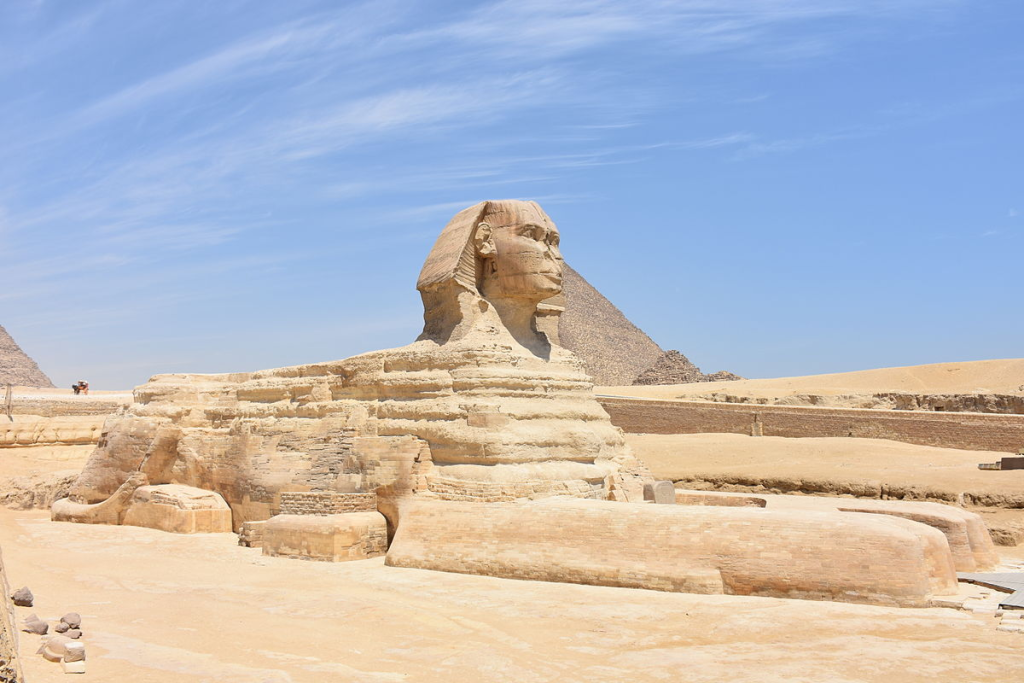
In the arid landscape of Dahshur, the Red Pyramid stands as a remarkable testament to ancient Egypt’s architectural prowess and innovation. Constructed during the reign of Pharaoh Sneferu, this pyramid is a true engineering marvel that exemplifies the ancient Egyptians’ mastery over monumental construction. In this comprehensive blog post, we delve into the captivating history, architectural brilliance, and cultural significance of the Red Pyramid of Dahshur.
Pharaoh Sneferu and His Legacy: The Red Pyramid, also known as the North Pyramid, was built to honor Pharaoh Sneferu, a ruler of the Fourth Dynasty. Sneferu’s reign is marked by his quest for perfection in pyramid construction, leading to the creation of several iconic pyramids. The Red Pyramid stands as a culmination of his architectural vision and legacy.
Architectural Ingenuity: The Red Pyramid’s claim to fame lies in its distinctive red limestone casing, which gives it its name. This pyramid boasts a base measuring approximately 220 meters (722 feet) per side and an original height of around 105 meters (345 feet). It is the world’s first successful attempt at constructing a true smooth-sided pyramid—a testament to the ancient Egyptians’ engineering prowess and their ability to learn and adapt from previous construction experiences.
Engineering Triumphs: The Red Pyramid’s ingenious construction techniques set it apart. Its accurately aligned sides and precise measurements are a testament to the ancient Egyptians’ mathematical and engineering skills. The internal layout of the pyramid includes a descending corridor, a vestibule, an ascending corridor, and burial chamber—a blueprint that was later perfected in the Great Pyramid of Giza.
Cultural and Symbolic Importance: The Red Pyramid, like other pyramids, held profound cultural and religious significance. In ancient Egyptian beliefs, pyramids were vehicles for the pharaoh’s transition to the afterlife and his eventual union with the gods. The Red Pyramid’s perfecting of the true pyramid design marked a symbolic connection between the earthly and divine realms.
Historical Insights and Preservation: The Red Pyramid continues to captivate researchers and archaeologists. Ongoing conservation efforts ensure that this historical treasure remains accessible for future generations. By studying its architecture, construction techniques, and the artifacts found within, researchers gain valuable insights into the ancient Egyptians’ techniques and the societal context of the time.
A Time Capsule of Achievement: The Red Pyramid of Dahshur stands as a beacon of human achievement and innovation. Its distinctive hue, precise construction, and its role in shaping the evolution of pyramid architecture make it an iconic symbol of ancient Egypt’s legacy. As we gaze upon its enduring form, we are transported back in time to an era of architectural exploration and the pursuit of perfection.
Best Tours to Egypt

4 Days Cairo and Abu Simbel Tour Package
Embark on an unforgettable 4-day tour package to Cairo and Abu Simbel, where ancient wonders and majestic temples await. Explore the iconic sites of Cairo, including the pyramids of Giza and the Egyptian Museum, before journeying to Abu Simbel to witness the breathtaking temples of Ramses II and Nefertari. With our carefully curated itinerary, knowledgeable guides, and inclusive services, this tour offers a compact yet immersive experience of Egypt’s rich history. Discover the secrets of the pharaohs, marvel at awe-inspiring architecture, and create lasting memories View Tour Details

5 Days Cairo and Alexandria Tour Package
Embark on a 5-day journey through Egypt’s most fascinating cities, Cairo and Alexandria. From the grand pyramids and ancient temples to the coastal beauty and cultural landmarks, this tour package is designed to showcase the best of both worlds. With expert guides, comfortable accommodations, and convenient transportation, you’ll have an immersive and hassle-free experience. Join us on this captivating adventure and create memories that will last a lifetime View Tour Details

6 Days Cairo, Luxor, Aswan & Abu Simbel Package
Embark on an extraordinary 6-day journey through the heart of ancient Egypt with our Cairo, Luxor, Aswan & Abu Simbel package. Begin your adventure in Cairo, where you’ll explore the iconic pyramids and delve into the treasures of the Egyptian Museum. Continue to Luxor and Aswan, where you’ll witness the grand temples along the Nile River, and conclude your tour with a visit to the awe-inspiring temples of Abu Simbel. With expert guides, comfortable accommodations, and hassle-free transportation, this package offers a comprehensive exploration of Egypt’s historic sites. Join us on this incredible journey and unlock the secrets of the pharaohs View Tour Details

7 Days Cairo, Luxor & Alexandria Tour
Experience the best of Egypt’s cultural and coastal attractions with our 7-day Cairo, Luxor & Hurghada holiday. Begin your journey in Cairo, where you’ll discover the iconic Pyramids of Giza, explore the ancient artifacts at the Egyptian Museum, and immerse yourself in the vibrant atmosphere of Egypt’s capital. Then, travel to Luxor, often referred to as the world’s greatest open-air museum, where you’ll explore magnificent temples, tombs, and archaeological sites. Finally, unwind in the idyllic beach destination of Hurghada, known for its pristine beaches and vibrant marine life View Tour Details
Related Egypt Tours Blog

Embark on an enchanting journey to the Giza Pyramids Complex, a testament to the ancient wonders of Egypt. Explore the iconic pyramids, unravel the mysteries of the Sphinx, and immerse yourself in the rich history of this UNESCO World Heritage Site. Join our guided tour to experience the awe-inspiring architecture, captivating legends, and breathtaking views of the Giza Plateau View Tour Details

The Saqqara Step Pyramid is a cornerstone of ancient Egyptian architecture, marking the transition from mastaba tombs to monumental pyramids. This guided tour takes you to Saqqara’s historical complex, where you’ll not only encounter the Step Pyramid but also explore fascinating tombs, chapels, and ancient structures View Tour Details

The Great Sphinx is an iconic masterpiece that has fascinated travelers for millennia. As you approach this enigmatic creature, you’ll feel the weight of history and the sense of wonder it evokes. Our expert guides will lead you through its mysteries and offer insights into the Sphinx’s role in ancient Egyptian culture View Tour Details
The Red Pyramid of Dahshur FAQs
- What is the Red Pyramid of Dahshur? The Red Pyramid of Dahshur is an ancient Egyptian pyramid located in the Dahshur necropolis, near Cairo. It is the burial place of Pharaoh Sneferu, a ruler of the 4th Dynasty during the Old Kingdom.
- Who was Sneferu? Sneferu, also known as Pharaoh Snefru, was a significant ruler of ancient Egypt during the 4th Dynasty. He is known for his contributions to pyramid construction and architectural innovations.
- Why is it called the Red Pyramid? The Red Pyramid gets its name from the reddish limestone that was used in its construction. This type of stone gives the pyramid its distinctive color.
- When was the Red Pyramid of Dahshur built? The Red Pyramid of Dahshur was built around 2613-2589 BCE during the Old Kingdom period of ancient Egypt.
- What is the significance of the Red Pyramid of Dahshur? The Red Pyramid is significant for being one of the earliest successful attempts at building a true smooth-sided pyramid. It also marks an important phase in the evolution of pyramid construction.
- What are the dimensions of the Red Pyramid of Dahshur? The Red Pyramid has a base measuring approximately 220 meters (722 feet) on each side and an estimated height of around 104 meters (341 feet).
- Is the Red Pyramid of Dahshur open to visitors? Yes, the Red Pyramid is open to visitors as part of the Dahshur archaeological site. Visitors can explore the interior of the pyramid and its surroundings.
- Can visitors enter the interior of the Red Pyramid of Dahshur? Yes, visitors are allowed to enter the interior of the Red Pyramid. However, access might be limited to certain areas or require special permits, so it’s best to check with authorities or tour guides.
- What can visitors see inside the Red Pyramid of Dahshur? Visitors to the Red Pyramid can explore the internal chambers and corridors of the pyramid, experiencing the layout of an ancient Egyptian burial structure.
- What makes the Red Pyramid unique in terms of its construction? The Red Pyramid is unique for being one of the earliest pyramids to feature smooth sides, a design that contributed to its stability and structural integrity.
- Are there any legends or myths associated with the Red Pyramid of Dahshur? While the Red Pyramid might not have as many legends or myths as some other pyramids, its historical and architectural significance contributes to the broader understanding of ancient Egypt.
- What is the significance of the Red Pyramid’s location in Dahshur? The Red Pyramid’s location in Dahshur is significant as it reflects the experimentation with different pyramid-building techniques and the evolution of pyramid design during the Old Kingdom.
- What is the entrance to the Red Pyramid of Dahshur like? The Red Pyramid has an entrance on its north side that leads to a descending corridor and internal chambers.
- What can visitors learn from the Red Pyramid of Dahshur? The Red Pyramid offers insights into ancient Egyptian architectural developments, engineering achievements, and the evolution of pyramid-building techniques.
- Are there any ongoing research or restoration efforts at the Red Pyramid of Dahshur? Ongoing research and restoration efforts are likely conducted to better understand the pyramid’s construction, history, and significance and to ensure its preservation.
- Can visitors climb the Red Pyramid of Dahshur? Climbing the Red Pyramid might not be allowed due to preservation and safety concerns. However, visitors can explore the complex and its surroundings.
- What are the burial chambers inside the Red Pyramid used for? The burial chamber of the Red Pyramid was intended to house Sneferu’s body, offerings, and funerary items, according to ancient Egyptian beliefs about the afterlife.
- Can I take photographs of the Red Pyramid of Dahshur? Photography regulations might vary, but in general, taking photographs inside and around the Red Pyramid for personal use could be allowed. Always follow local guidelines.
- What should I keep in mind when visiting the Red Pyramid of Dahshur? When visiting the Red Pyramid, respect the historical site, adhere to local regulations, and appreciate the opportunity to explore a pyramid with unique construction and architectural significance.
- How does the Red Pyramid contribute to our understanding of ancient Egyptian architecture? The Red Pyramid is a significant example of the evolution of pyramid-building techniques in ancient Egypt. Its smooth sides and successful construction showcase the engineering prowess of the time and offer valuable insights into the development of monumental architecture.

